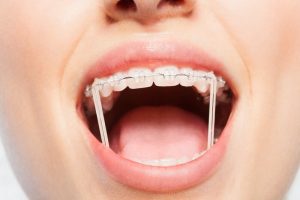 There are two types of elastics used in orthodontics. The first kind, called ligatures, is the tiny colorful one that holds the wires of your braces in place. Your orthodontist replaces the ligatures at every visit.
There are two types of elastics used in orthodontics. The first kind, called ligatures, is the tiny colorful one that holds the wires of your braces in place. Your orthodontist replaces the ligatures at every visit.
Orthodontic rubber bands, the second type, are larger and stretchier. These elastics are very important tools that help align your bite and jaw position.
What are orthodontic elastic bands?
Orthodontic rubber bands are effective at correcting underbites, overbites, open bites, and crossbites. These elastics create the force needed to move your teeth and jaw into the correct alignment.
Orthodontic rubber bands are attached in various configurations and angles to get the tensile force that will correct your bite. Sometimes, an orthodontist will also use the rubber bands to push or pull a particular tooth or teeth into the proper position. Elastics are usually added to the treatment process 4 to 6 months after you get your braces.
How do these elastics work?
Brackets, archwires, and ligatures help align your teeth by moving them along the gumline. Meanwhile, orthodontic rubber bands align the top and bottom rows of your teeth by pulling your jaw backward or forward.
Your orthodontist attaches the elastics to the brackets using hooks. The bands connect the bottom tooth bracket with the top tooth bracket.
Over time, the pressure created by the elastics helps your teeth fit together and gives you a more comfortable and better-looking bite. They are also critical in speeding up the process of straightening or repositioning your tooth or teeth.

